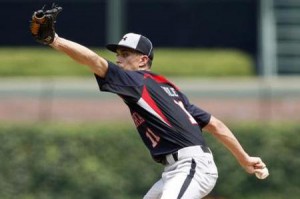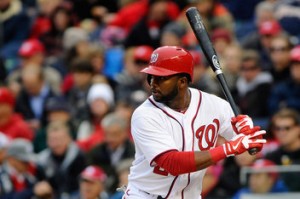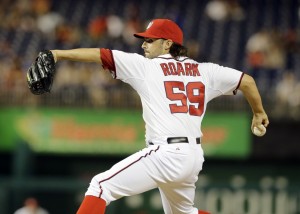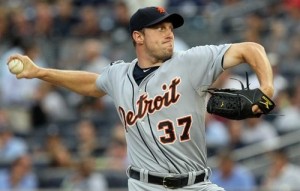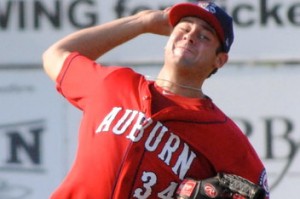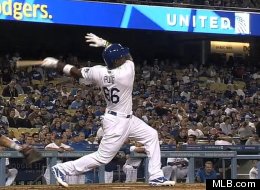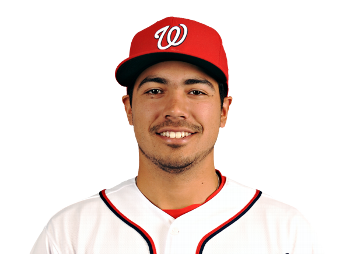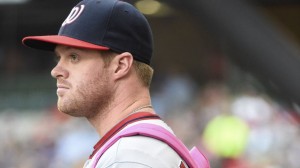All our full-season squads have been announced, and its time to start looking at the pitching staffs.
I never got to doing my massive reviews of the rotations of the various farm system teams this past off-season (job change, less free time at home, they being a ton of work, etc). Which also led to my not doing any predictions on where our pitchers would start the 2015 season. Which is a bummer, because it is always fun to see if my predictions were decent and to see how player movement has affected the squads. Lets go team by team and (focusing on the rotations) look at how things have changed since the end of last season.
MLB (25-man roster announcement here)
- 2015 Rotation: Scherzer, Zimmermann, Strasburg, Gonzalez, Fister
- 2014 Opening Day Rotation: Strasburg, Gonzalez, Zimmermann, Roark, Jordan
- 2014 Closing Day rotation: Strasburg, Gonzalez, Zimmermann, Fister, Roark
Discussion: We’ve certainly talked this through. Quickly; Fister‘s 2014 spring training injury opened the door for both Roark and Jordan to duke it out for the 2014 5th starter job, eventually won by Roark, who gave the team a 5-win season as the 5th starter. That wasn’t enough for the Nats though; committing $210M on Scherzer for the next decade or so, pushing Roark to mop-up guy/insurance starter for opening of 2015.
Manager Matt Williams also shook up the 2015 rotation order, installing the starters by accomplishment, not by reputation. Thus 3-year running opening day starter Strasburg is dropped to the #3 hole, and last year’s #2 Gonzalez is now basically the #5 starter.
Enough about the MLB discussion though; lets get to the minor league rotations.
All four full season minor league squads are announced here by Nats Journal. In some cases we know who the rotation will be, in other cases the below is a huge guess. Especially at Hagerstown (as we’ll see).
AAA (Syracuse roster announcement link)
- 2015 Rotation: Cole, Jordan, Hill, McGregor, Billings (with Lively, Rivero (L) as swingmen)
- 2014 Opening Day Rotation: Rosenbaum (L), Hill, Tatusko, Treinen, Poveda
- 2014 Closing Day rotation: Laffey (L), Hill, Treinen, Lively, Cole (Espino 9/1 call-up)
Discussion
A late spring training injury to Casey Janssen has called presumed AAA starter Blake Treinen into action in the Nats bullpen, perhaps for the long run. Which has opened up a couple of spots in the Syracuse rotation … and they’ve been surprisingly filled. Instead of installing who I presumed to be the 5th AAA starter (trade acquisition Felipe Rivero), the team has announced that 2014 MLFA signing/rubber-armed swingman Scott McGregor and 2015 MLFA Bruce Billings will fill out the rotation.
Changes from 2014? Rosenbaum traded for catcher depth, Tatusko to Korea, Poveda remains an unsigned MLFA, and Laffey signed a new MLFA deal with Colorado.
One has to think that McGregor/Billings are temporary holds in the rotation until Treinen returns. The conversion of Rivero to the bullpen is more interesting; the team is rather short on lefty starters in the system right now (thanks to a slew of upper-end draft pick lefty starters failing in the past few years … ahem Solis, Purke, Mooneyham, Turnbull). As we’ll see later on, there’s nobody really that makes sense to supplant any of these guys as a starter from AA or XST.
AA (Harrisburg roster announcement here)
- 2015 Rotation: Voth, Ross, Espino, Alderson, Swynenberg (with Bleier (L) perhaps as a swingman?)
- 2014 Opening Day Rotation: Schwartz, Rivero (L), Gilliam, Purke (L), Cole
- 2014 Closing Day rotation: Dupra (sort of), Voth, Rivero (L), Poveda, (Espino 9/1 promotion), Kroenke
Discussion
Harrisburg went through an awful lot of starters last year. 19 guys got starts, 15 of which were not just one-offs. From last year’s opening day, Schwartz got demoted after putting up a 7+ ERA and then hurt, Gilliam got hurt, and Purke had Tommy John surgery. By the end of the season, only Rivero remained in the rotation, though he spent a good spell on the D/L as well. Dupra got 12 starts and 24 appearances and was medicore (5.60 ERA), Poveda had great ratios (39Ks in 32innings) but an ugly era (5.34), and MLFA Kroenke was abhorrent (6.72 ERA).
Returning for 2015 are Austin Voth, the 2013 draft pick who shot up two levels last year, and last year’s MLFA Paolo Espino, who has re-upped with the team for 2015. They are joined by newly acquired Joe Ross, MLFA Tim Alderson and the surprising Matt Swynenberg (who was closer to retirement than a rotation gig this time last year). I have 2015 MLFA Richard Bleier as a swingman/spot starter for now. This rotation may be augmented by some of the Missing/XST arms (see later discussion).
High-A
- 2015 Rotation: Bacus, Pivetta, Spann (L), Suero, Rauh (with Schwartz as swingman?)
- 2014 Opening Day Rotation: Rauh, Rpena, Mooneyham (L), Encarnacion, Lee (L)
- 2014 Closing Day rotation: Bacus, Spann (L), Dickson, Sylvestre, Rauh,
Discussion
Lots of turnover in the Potomac rotation as well; 14 guys got starts from last year. Dakota Bacus, Brian Rauh, and Matthew Spann are reprising their roles as starters from the end of last season, while two others (Dickson and Sylvestre) remain in XST limbo for now. What happened to the rest of these guys? Brett Mooneyham and Nick Lee posted ERAs of 7.36 and 10.05 respectively and were both demoted. Encarnacion was nearly as bad and was outright released by the organization earlier this past off-season.
Luckily, we kind of already know that the opening day rotation is going to change: we know where two of the organization’s brightest arms are heading. Giolito and Lopez should supplant Bacus and Rauh, making for a rather formidable Potomac rotation.
Low-A
- 2015 Rotation: AWilliams, LReyes, Van Orden … and then who knows. Orlan? Ullman?
- 2014 Opening Day Rotation: Pivetta Voth, Giolito, Silvestre (L)/Anderson, Johansen,
- 2014 Closing Day rotation: Pivetta, RLopez, Ott, Dickey, Suero,
Discussion
Well; Hagerstown’s rotation should be … interesting. When you look at the assigned arms, there’s only three clear-cut starters from last year. So clearly either the Hagerstown team will be getting reinforcements from the XST list or there’s guys being converted from 2014 relievers to 2015 starters.
Pivetta and Giolito were the mainstays from last year; both will be in high-A at some point soon. Ott was flipped as a throw-in with the Steven Souza deal. Its hard to pass judgement on this rotation until we talk about those in XST.
Missing/XST
There’s a TON of arms who are currently unassigned.
Starters: JRodriguez, Dickey, Dickson, Estevez, Lopez, Giolito, Simms, Silvestre, Bourque, Amartinez, Gilliam
Relievers: Purke, Bates, Holland, Lehman, Mooneyham, Pena, Simmons, Solis, Turnbull, Feliz, McDowell, Torres, DWilliams
Where might these guys end up? Well, based on their performance from last year, here’s some guesses for the starters:
- AAA: nobody who isn’t already there
- AA: Simms, Silvestre, Gilliam
- High-A: Dickey, Dickson, Lopez, Giolito, Dupra (already on the Potomac D/L)
- Low-A: JRodriguez, Estevez, Bourque, AMartinez
And the relievers?
- AAA: Purke (already on the AAA D/L), Holland, Lehman (release candidate), Simmons (release candidate)
- AA: Bates (release candidate), Pena, Solis
- High-A: Mooneyham, Turnbull
- Low-A: Feliz, McDowell, Torres, DWilliams
We’ll see how things go; I guess we could start seeing some minor league releases soon enough.
